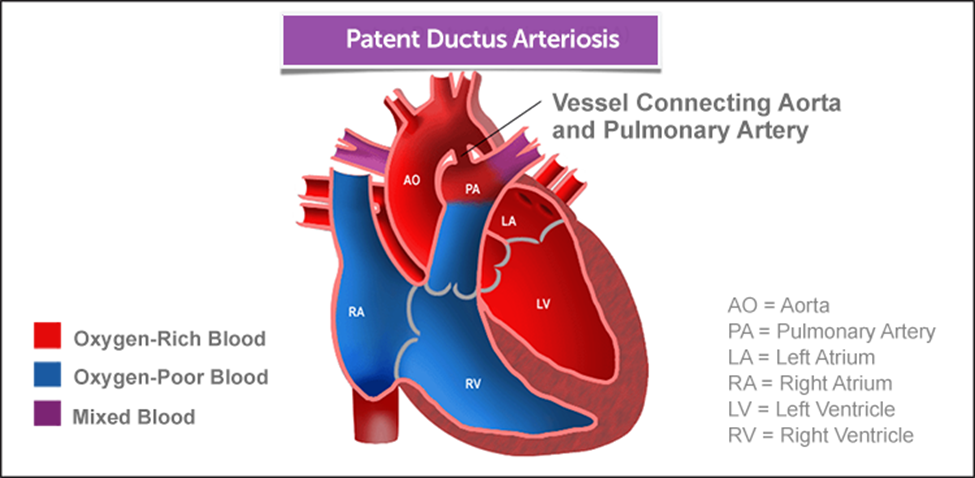The registered nurse is discussing care of an infant diagnosed with a patent ductus arteriosus (PDA) with a nursing student. The registered nurse determines that the nursing student needs further teaching regarding a PDA when the student states that which circulatory change is a characteristic of this disorder?
This shunting allows oxygenated and unoxygenated blood to mix.
Blood is shunted to the right side of the heart.
This shunting results in increased pulmonary blood flow.
Blood is shunted to the left side of the heart.
The Correct Answer is D
A. "This shunting allows oxygenated and unoxygenated blood to mix."
Explanation: This statement is correct. In PDA, the shunting of blood between the aorta and pulmonary artery allows oxygenated and unoxygenated blood to mix, leading to decreased oxygen saturation in the systemic circulation.
B. "Blood is shunted to the right side of the heart."
Explanation: This statement is correct. In PDA, blood is shunted from the left side of the heart (aorta) to the right side of the heart (pulmonary artery).
C. "This shunting results in increased pulmonary blood flow."
Explanation: This statement is correct. PDA leads to increased pulmonary blood flow as a result of the shunting of blood from the aorta to the pulmonary artery.
D. "Blood is shunted to the left side of the heart."
Explanation:
A patent ductus arteriosus (PDA) is a congenital heart defect where the ductus arteriosus, a fetal blood vessel that normally closes shortly after birth, remains open. In PDA, blood is shunted from the aorta (left side of the heart) to the pulmonary artery (right side of the heart), resulting in increased pulmonary blood flow. Therefore, the correct statement is that "Blood is shunted to the right side of the heart."

Nursing Test Bank
Naxlex Comprehensive Predictor Exams
Related Questions
Correct Answer is ["B","D","E"]
Explanation
A. Need for increased caloric intake:
Incorrect: While toddlers may have specific nutritional needs, it is important to focus on a balanced diet rather than emphasizing increased caloric intake. The emphasis should be on providing nutritious and age-appropriate foods.
B. How to encourage cooperative play:
Correct Answer: Encouraging cooperative play is important for a toddler's social development. It involves teaching sharing, taking turns, and interacting with other children.
C. Management of tantrums:
Incorrect: While guidance on managing tantrums can be part of parenting education, it may not be the primary focus in health promotion teaching. The emphasis is typically on positive guidance, effective communication, and setting age-appropriate limits.
D. Dental care:
Correct Answer: Dental care is crucial for toddlers to promote oral health. The nurse should provide information on proper oral hygiene practices, including tooth brushing, and discuss the importance of regular dental check-ups.
E. How to establish trust:
Correct Answer: Establishing trust is a vital aspect of toddler development. The nurse can provide guidance on building a secure and trusting relationship between the child and parents.
Correct Answer is D
Explanation
A. Brachial artery:
Incorrect: The brachial artery is commonly used for measuring blood pressure in infants but not for assessing heart rate.
B. Radial artery:
Incorrect: The radial artery is not typically used for assessing an infant's heart rate, especially in the clinical setting.
C. Carotid artery:
Incorrect: The carotid artery is not commonly used for assessing an infant's heart rate. It is more commonly used in adults, but in infants, the apex of the heart is the preferred site.
D. Apex of the heart.
Correct Answer: The apex of the heart is the most accurate site for counting an infant's heart rate. It is located at the point of maximum impulse (PMI), which is usually at the fifth intercostal space in the mid-clavicular line.
Whether you are a student looking to ace your exams or a practicing nurse seeking to enhance your expertise , our nursing education contents will empower you with the confidence and competence to make a difference in the lives of patients and become a respected leader in the healthcare field.
Visit Naxlex, invest in your future and unlock endless possibilities with our unparalleled nursing education contents today
Report Wrong Answer on the Current Question
Do you disagree with the answer? If yes, what is your expected answer? Explain.
Kindly be descriptive with the issue you are facing.
